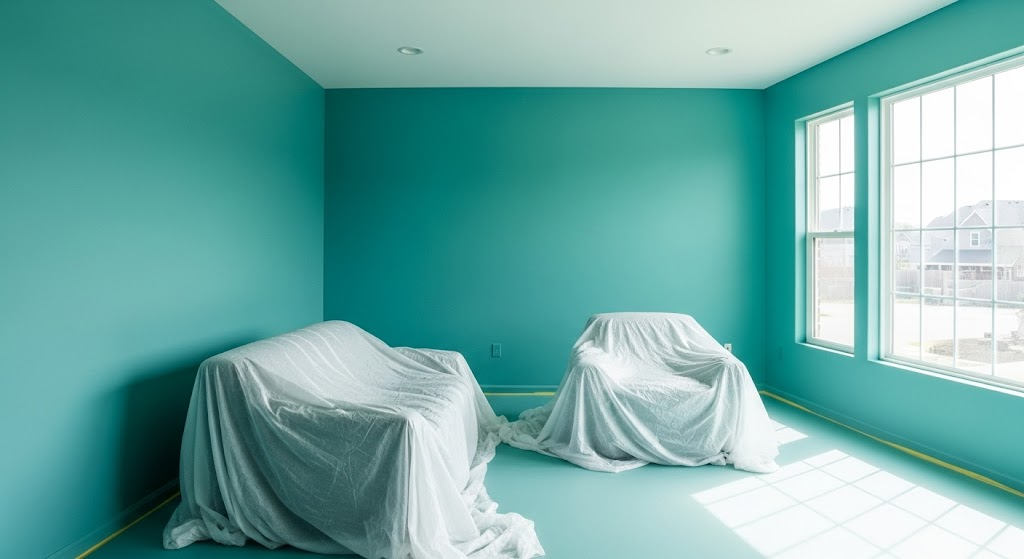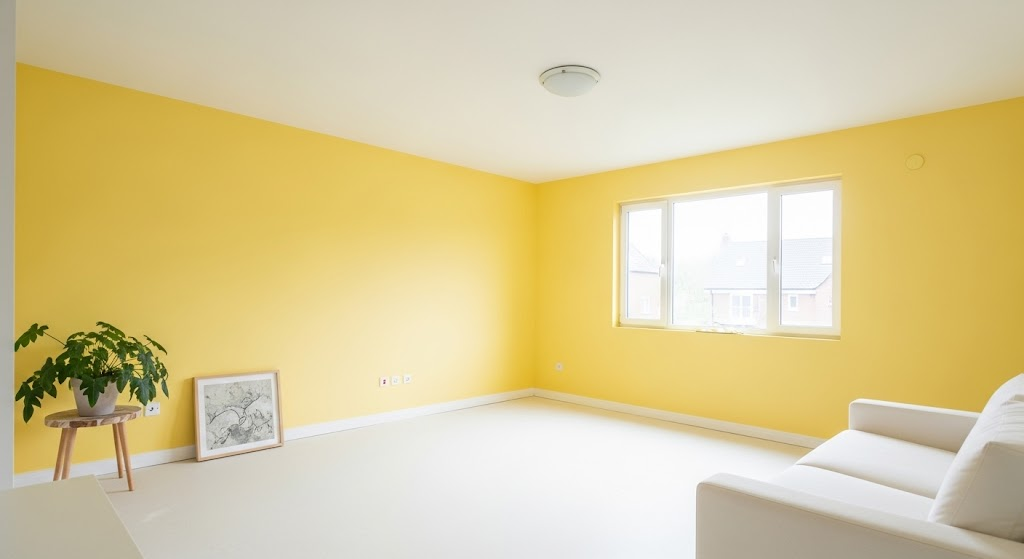When I started painting my own walls, I assumed the drying process was quick and straightforward.
But after smudging fresh paint and recoating too early, I realized drying times are a lot more complex than they seem.
Different paints, finishes, surfaces, and even the weather can significantly impact how quickly or how slowly your project dries.
In this blog, I’ll break it all down in plain terms. I’ll share what I’ve learned through experience and research to help you get the best results without the guesswork.
Let’s take the mystery out of drying time so you can finish your project with confidence.
What Does “Dry” Really Mean?
When I first started painting, I assumed ‘dry’ meant ‘done’, but it’s not that simple. Paint dries in phases.
First, it becomes touch dry, where the surface feels dry but the layers underneath are still soft.
Then comes the recoat stage, when it’s safe to apply another layer without disturbing the one beneath. This timing is crucial for avoiding peeling or uneven finishes.
Finally, there’s a cure time, the point when the paint fully hardens and reaches maximum durability.
This process can take anywhere from a few days to a few weeks, depending on the type of paint, its thickness, and the environmental conditions.
Even if a wall feels dry, it may not be ready for cleaning, heavy use, or pressure washing. I’ve learned to wait for that complete cure, especially on furniture and trim; it’s worth it for a smooth, lasting finish.
What Affects Paint Drying Time?

Drying paint depends on more than just the passage of time. Over time, I’ve learned that several key factors work together to affect how quickly your paint sets:
1. Paint Type
The drying time largely depends on the type of paint used. Paint finish affects dry time due to sheen level and ingredients.
- Flat & Matte: Dry a bit faster, but may be harder to clean.
- Eggshell & Satin: Moderate dry time, suitable for most living areas.
- Semi-Gloss & Gloss: Slower drying due to higher resin content. These are ideal for kitchens, bathrooms, and trim where durability is a priority.
2. Temperature
Temperature affects how fast paint dries. Most paints work best between 50°F and 85°F (10°C to 29°C). Cold weather slows drying and can lead to poor adhesion, while heat can dry the surface too fast before the layers underneath are ready.
- Kitchens: Often humid; use fans and allow extra drying time.
- Bathrooms: Similar to kitchens, humidity slows down drying. Ventilation is key.
- Bedrooms/Living Rooms: Usually ideal, especially if windows can stay open.
- Garages/Basements: May be cold or damp, use heaters or wait for a dry day.
3. Humidity
Humidity affects paint drying by influencing the evaporation rate of water or solvents. An ideal indoor humidity level ranges between 40% and 60%.
- High humidity levels slow down evaporation, keeping the paint wet for longer and increasing the risk of smudging or poor adhesion.
- Low humidity levels can cause paint to dry too rapidly, which may lead to cracks or an uneven surface.
4. Surface Type
Different surface materials absorb paint at varying rates. Proper preparation, including cleaning and priming, helps create consistent conditions and promotes faster and more even drying.
- Drywall: Dries quickly, especially if primed. Great for quick-turnaround projects.
- Wood: Can absorb paint unevenly, especially if unsealed—requires more drying time.
- Metal: Needs special primers and dries faster with thin coats.
- Concrete or Brick: Very porous and may require multiple coats and longer drying time between coats.
5. Airflow & Ventilation
Adequate airflow supports faster drying by helping moisture evaporate more efficiently.
Good ventilation, such as opening windows or using circulating fans, can significantly reduce drying times.
However, direct airflow should be avoided as it may cause uneven drying or visible streaks.
Balanced ventilation allows for a steady exchange of air, which is essential for both water-based and oil-based paint applications.
6. Coat Thickness
The thickness of the applied paint layer directly impacts drying time.
Thick coats take longer to dry and are more likely to result in drips, uneven texture, or extended cure time.
Applying multiple thin coats instead of one heavy layer ensures faster drying, improved coverage, and a more consistent finish.
Most paint manufacturers recommend thin, even applications for best results
How Quickly Do Different Paints Dry?

Compare the drying, recoating, and curing times of popular paint types to choose the best option for your project timeline.
| Paint Type | Touch Dry | Recoat Time | Fully Cured | Notes |
|---|---|---|---|---|
| Latex | 1 hour | 4 hours | 2–3 weeks | Dries fast and is easy to clean; ideal for walls and ceilings. |
| Oil-Based | 6–8 hours | 24 hours | 7–10 days | Very durable; best for trim, doors, and cabinetry. |
| Spray Paint | 15–30 minutes | 1–2 hours | 24–48 hours | Best for small or detailed projects; apply in thin, even layers. |
| Chalk Paint | 30 minutes | 1 hour | 7 days (with sealer) | Great for furniture; quick-drying but still needs time to fully cure. |
When Is Paint Truly Dry?
Learn how to tell when paint is fully dry, from touch-dry to cured, so you can safely recoat, clean, or use your freshly painted surface.
- Touch dry: You can lightly press your fingertip to the surface, and it’s no longer tacky.
- Recoat-ready: Paint isn’t just dry on the surface—it’s stable enough to support another layer.
- Fully cured: This is when paint reaches full hardness and durability. It won’t smudge, dent, or peel.
This is a good general guide I follow:
- Wait 1 hour for most latex paints to be touch-dry.
- Wait 4–6 hours before applying a second coat.
- Wait 2–3 weeks before scrubbing, cleaning, or decorating.
Tip: Still unsure? Lightly press your fingernail into the surface. If it leaves a dent, it’s not fully cured.
Tips to Speed Up Drying
Simple and effective tips to help you speed up paint drying time without compromising the finish or quality of your project.
- Use fans: Increase airflow without aiming it directly at the surface.
- Open windows: Good ventilation can make a big difference (as long as it’s not too humid).
- Thin coats only: Thick paint takes ages to dry and often doesn’t look great.
- Use a dehumidifier: Especially helpful for bathrooms or basements.
- Choose fast-drying formulas: Some latex paints are designed to dry in as little as an hour.
Mistakes That Can Slow Things Down
Avoid these common painting mistakes that can slow down drying time and lead to uneven finishes or extended project delays.
- Skipping primer on raw surfaces: Paint soaks in and takes forever to dry.
- Painting in cold or humid rooms: It slows everything down and can cause the paint to dry unevenly.
- Applying thick, heavy coats: Looks patchy and takes longer to cure.
- Recoating too soon: The first layer lifts or smears, wasting time and paint.
Conclusion
Drying time isn’t just about checking the clock; it’s about understanding the paint, the space, and how all the conditions come together.
Once I started paying attention to temperature, humidity, and surface type, my paint jobs looked cleaner, lasted longer, and gave me fewer headaches.
So if you’re wondering how long to wait before that next coat or when it’s safe to move furniture back in, just take a breath and give it time.
Test a small area, trust your touch, and don’t rush the process. It’s always better to wait a little longer than to redo the whole thing.
Let me know how your next project turns out. I’d love to hear what worked for you!
Frequently Asked Questions
When can I apply a second coat?
Wait 2-4 hours before recoating latex paint, and 6-24 hours for oil-based, as per product instructions.
How long should I wait before hanging pictures on a freshly painted wall?
Wait at least 24–48 hours before hanging anything. For best results, allow the paint to fully cure, typically in 1–2 weeks.
What happens if I recoat too soon?
Recoating too early can cause streaks, peeling, or uneven coverage. Always follow the recommended dry time on the paint can to avoid ruining the finish.
Does ceiling paint dry faster than wall paint?
Not necessarily. Drying time depends on the paint type, room conditions, and coat thickness, not the surface orientation. Ceilings may dry more slowly if ventilation is limited.

